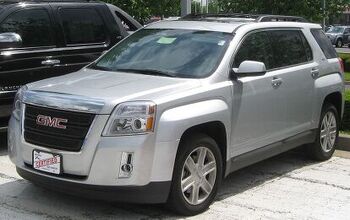Unifor Strike Targets General Motors in Canada

While the United Auto Workers (UAW) decided to implement an aggressive strike campaign that bucks some of the historical trends American union leadership feels did not serve the cause in the past, Canada’s Unifor has vowed to take a more measured approach during its contract negotiations with the industry. However, that does not mean simply rolling over for automakers in order to strike any old deal.
Last week, Unifor criticized General Motors for failing to meet important elements of its pattern agreement with Ford Motor Company. With both sides failing to make any tentative agreements by the Monday deadline, Unifor has announced plans to strike in Ontario — hindering the company’s ability to manufacture light and heavy-duty pickups.
The Canadian walkout is reportedly down to GM "stubbornly refusing" to match the contract the labor union had already reached with Ford, including a wage increase of up to 25 percent and improved benefits. Demands are similar to what we’ve seen from the UAW.
"The company continues to fall short on our pension demands, income supports for retired workers, and meaningful steps to transition temporary workers into permanent, full-time jobs," Unifor National President Lana Payne stated.
With the UAW having been striking since mid-September, automakers are already assumed to be losing millions of dollars each week due to production shortfalls. Unifor is targeting GM's Oshawa assembly complex, St. Catharines powertrain plant, and Woodstock parts distribution center. This will further hamper the company’s ability to manufacture the extremely lucrative Silverado pickup as well as the powertrains those (and other) GM products use.
The automaker has said it would “remain at the bargaining table” and remains “committed to keep working with Unifor to reach an agreement that is fair and flexible.” But it also claimed to be disappointed that a deal failed to be reached with the union after “very positive progress on several key priorities over the past weeks.”
Unifor is similarly disappointed. But said that GM failed to adhere to the pattern agreement made with Ford, leaving the union with no other recourse.
That agreement applies to over 5,600 Canadian employees located at Ford factories and has already been ratified by a narrow majority of union members. It offers a nearly 20 percent wage hike (25 for trades over a lifetime agreement), general wage increases over the next three years (with a 10 percent bump coming in 2024), a restoration of cost-of-living adjustments, the timeline for standard wage progression to be halved to just 4 years, improvements to all pension plans, a $10,000 Productivity and Quality bonus for full-time employees ($4,000 for part-timers), improvements to healthcare, improvements to retirement benefits, special EV transition measures for workers located at Ford’s Oakville Assembly, and more.
[Image: General Motors]
Become a TTAC insider. Get the latest news, features, TTAC takes, and everything else that gets to the truth about cars first by subscribing to our newsletter.

A staunch consumer advocate tracking industry trends and regulation. Before joining TTAC, Matt spent a decade working for marketing and research firms based in NYC. Clients included several of the world’s largest automakers, global tire brands, and aftermarket part suppliers. Dissatisfied with the corporate world and resentful of having to wear suits everyday, he pivoted to writing about cars. Since then, that man has become an ardent supporter of the right-to-repair movement, been interviewed on the auto industry by national radio broadcasts, driven more rental cars than anyone ever should, participated in amateur rallying events, and received the requisite minimum training as sanctioned by the SCCA. Handy with a wrench, Matt grew up surrounded by Detroit auto workers and managed to get a pizza delivery job before he was legally eligible. He later found himself driving box trucks through Manhattan, guaranteeing future sympathy for actual truckers. He continues to conduct research pertaining to the automotive sector as an independent contractor and has since moved back to his native Michigan, closer to where the cars are born. A contrarian, Matt claims to prefer understeer — stating that front and all-wheel drive vehicles cater best to his driving style.
More by Matt Posky
Latest Car Reviews
Read moreLatest Product Reviews
Read moreRecent Comments
- Cprescott I installed hood struts on my 2016 Elantra by carefully noting that ones sold outside of the states had struts in some applications. I then found the size and ordered them from Amazon and bolted them in without drilling any holes. First one was the hardest but after I learned how to adjust and to place, it was 5 minutes to install.I do wish the trunk spring was stronger to allow the trunk lid to open all of the way instead of half way.
- Cprescott From a real world perspective.Golf carts do not have to be fast. They can easily be as slow as the market average for the segment they compete. An affordable car does not need to accelerate to 60 mph faster than 8 seconds at the entry price point.Lowering the speed requirements also means you can reduce the size of the rear or front wheel drive motor - you don't need four wheel drive. Reducing that motor means less weight. All of the other components can also be downsized and someone needs to innovate so that these components other than the motor are modular and can be plugged into each other for easy repair without using cords.Reduce the size of the vehicle to less than 180 inches in overall length. Do not build it like it is an SUV as that adds height and weight. Make it a car - sedan or wagon. No need for sunroof or glass roof. Remove as much cost out of the unit for unneeded basic transportation.
- 28-Cars-Later So Mr. Farley is out in 2025 for his continued faux pas?
- 1995 SC Id find whoever Ford used in the mid 90s. My hood struts are original and still work and it isnt like the hood never goes up on that thing
- Lichtronamo You have to wonder what Ford has been doing since canning development of cars as the cadence of EV launches since that time has been almost non-existant.


































Comments
Join the conversation
GM was afraid of a ton of Payne.
The agreement basically mirrors the one that UNIFOR negotiated with Ford Canada. And that only received a 54% in favour vote by the UNIFOR members at Ford. GM however has generally an older workforce, so the pension clause will add more cost to GM than to Ford. What shocked me the most is that there were only 4,300 UNIFOR members in the bargaining unit(s) involved. I remember when GM employed well over 10,000 in Oshawa alone.
Next up is Stellantis (Chrysler) Canada which shockingly is the largest employer of unionized auto workers in Canada among the D3 with just over 8,000.
Union leadership expects a much tougher time with Stellantis. Perhaps because there are currently no vehicles for Brampton and the mini-vans in Windsor are not exactly hot sellers.